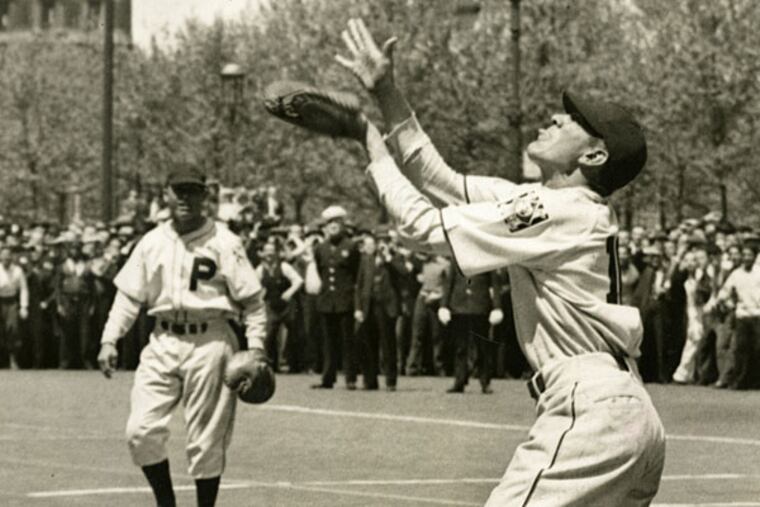Remembering a Phillies stunt
There's no record of what was going through Dave Coble's head as the Phillies catcher circled beneath a baseball that had been tossed from City Hall's tower, some 521 feet above.

There's no record of what was going through Dave Coble's head as the Phillies catcher circled beneath a baseball that had been tossed from City Hall's tower, some 521 feet above.
It's a good bet, though, he hoped it wouldn't be the ball.
Seventy-five years ago Saturday, May 10, 1939, thousands gathered on the north side of City Hall for a bizarre and risky stunt, one designed to publicize both the woeful Phillies and a Newspaper Guild charity event.
The first eight high-altitude heaves that day - including one that landed amid the crowd - eluded Coble and three teammates, all of whom wore Phillies uniforms and had been supplied with leather football helmets.
Finally, to the delight of a roaring crowd, the ninth thudded into Coble's mitt.
While in the 21st Century baseballs occasionally are dropped from helicopters or by parachutists during opening day ceremonies, the game's marketing sophistication and safety concerns have virtually eliminated the dangerous spectacle.
In 1939, two months after the Philadelphia exhibition, a San Francisco Seals player named Joe Sprinz broke his jaw and five teeth, tore his lip, and was knocked unconscious attempting to catch a ball dropped from an 800-foot tower.
Until then, however, such ball-drops were popular promotional gimmicks in a Depression-era America obsessed with crazy stunts.
A year earlier, to considerable national acclaim, a Cleveland Indians player caught two balls dropped from that city's 708-foot Terminal Tower.
"And I found at least four times in 1939 when baseball teams did the same thing," said Dennis Link.
Link, 45, of Lansdale, is a Society of American Baseball Research member. He began investigating details of Coble's catch shortly after he learned of it in 2009 at a SABR convention.
"I'd been a Philadelphia baseball fan all my life," he said, "and I'd never heard a word about it."
Well-publicized at the time, the event was the brainchild of the Guild, a union for white-collar newspaper employees. Guild officials coaxed cooperation from the Phillies, who were bound for a 45-106 season and desperate for anything to boost interest.
It worked. Ten-thousand fans - 3,000 more than attended the Phils' 4-3 loss to St. Louis at Shibe Park later that day - came to watch manager Doc Prothro and catcher Spud Davis drop balls from the then open-air observation area at the base of the Billy Penn statue.
An Associated Press photo shows Coble, who was a 25-year-old backup, and three Phillies teammates - fellow catcher Walter Millies, infielder Del Young, and outfielder Gil Brack - gazing upward.
According to Link, at least one account suggested Coble had backed out of ball-dropping duty because he was afraid of heights. If so, he should have had some ball-catching anxiety too.
The Franklin Institute estimated a baseball plummeting earthward from that height would be moving at 184 m.p.h. and would strike a glove with the force of a 73-pound object.
The stunt was scheduled to last until a catch was made. Each ball was barely visible as it began its descent and the players on the ground were notified before each drop via shortwave radio.
It's not clear if all four Phillies chased each ball or if they went in some prearranged order. But apparently only Coble and Millies got close to grabbing one.
Bulletin sports columnist Lynn Doyle, who had enthusiastically promoted the event, wrote in some detail about what transpired that day.
Coble caught the first ball, but on a bounce. Millies missed the second. A third, drifting in the breeze, scattered the fans. Millies failed to grab two more. The sixth ball struck a concrete island near North Broad Street. Coble tripped on the same island chasing the seventh, then mishandled the eighth.
Finally, on the ninth try, Coble gloved one.
It felt, he told reporters, like "a man jumping into my arms."
Six of the balls, Link said, were collected and auctioned off at the Newspaper Guild's Jamboree and Dance, held May 13 at the nearby Town Hall.
"I never found out what became of the other ones," he said.
Coble's catch would be the highlight of a dismal season in which the Phils finished last, 50 games out of first place, 18 games out of seventh. It also was the most noteworthy achievement of Coble's brief career.
A North Carolinian, he played in just 15 games, none after Aug. 6, hit .280, and was later released. He served in the Army during World War II and as a scout for Connie Mack's Athletics before he died at 58 in 1971.
When SABR convened here last summer, Link presented a brief power-point presentation on Coble's catch. He hopes at some point to return to the subject and some unanswered questions surrounding it.
"It just struck me as something so interesting that I couldn't believe I never knew about it," he said.
@philafitz